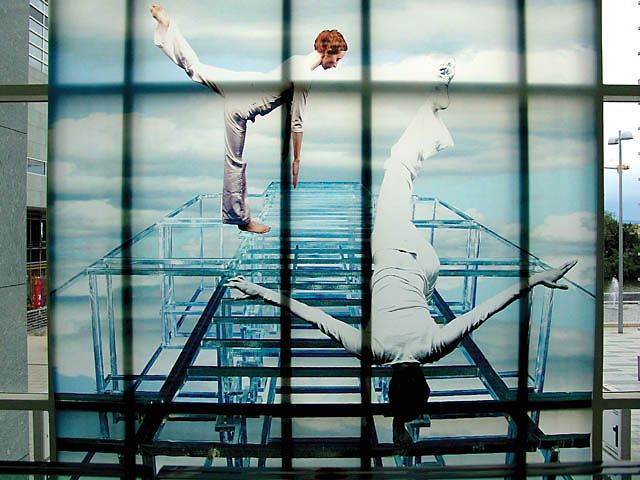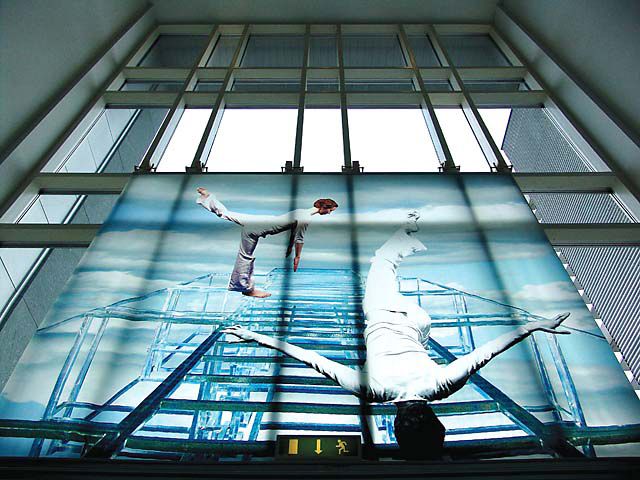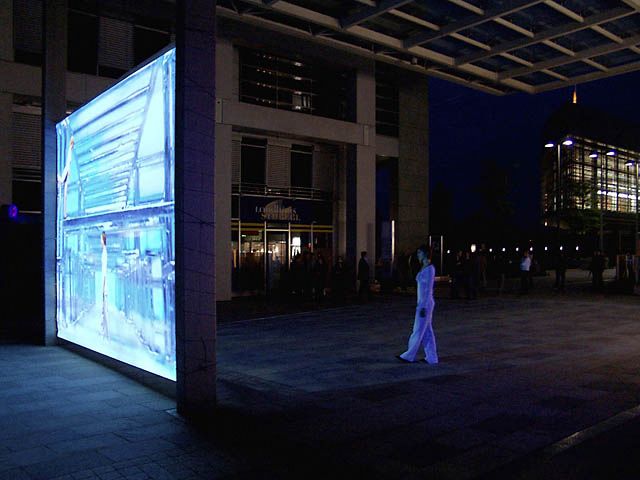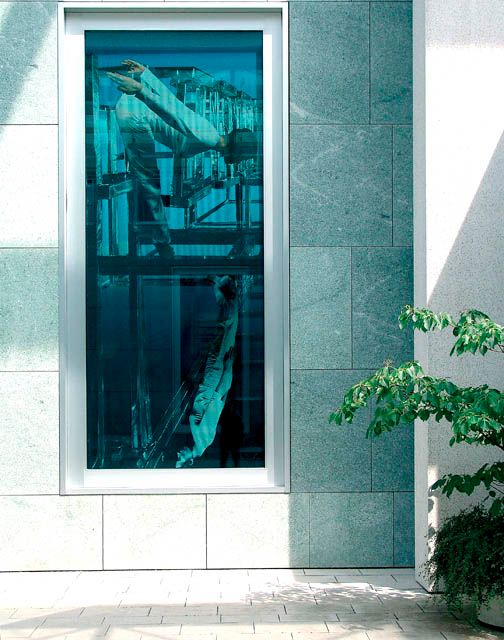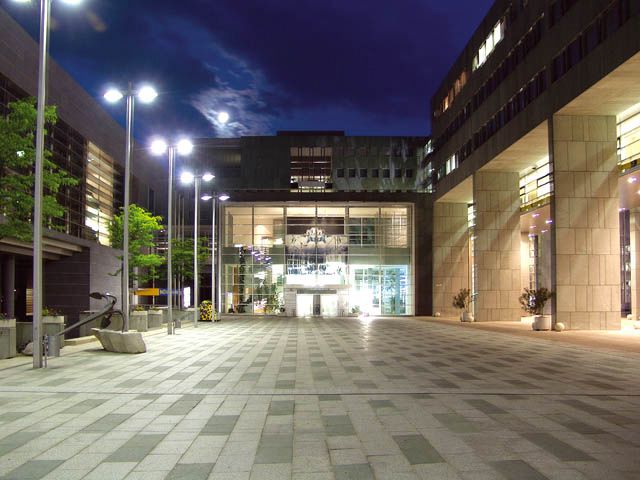Markus Wintersberger
:
Eutopia Bodyland.dancehouse.virtualboulevard
Back
Information
Scenography in Virtual Space for the Regierungsviertel in St. Pölten
Concept, production, video: Markus Wintersberger
Live performance: Stephanie Cumming, Julia Mach
Live sound: Alois Huber
Installation: 22 June to 11 July, 2004
The location of the performance EUTOPIA embodies the political power of the province state of Lower Austria. In Foucault's idiom, the visibility of an order of things is manifested in the buildings of the Regierungsviertel, while what can be told of this order is shown in the law texts and administrative paperwork that are followed and put into practise by the civil servants of this government. So much for a conventional reading of the state apparatus, even if this does not tally with the political reality at all, where, as we know, the local and national are disappearing in favour of the global. This bears witness to the asymmetry of the new power structures, which certainly cannot be fixed topographically – in much the same way that talk of an asymmetrical war of terror implies it can emerge anywhere, anytime. Contemporary power structures have no centre, no privileged location. However perhaps in times like these in particular there is a need for the familiar monumental and centrally built symmetry of local political manifestations that attests to a 'state of normality' – as a kind of compensation. Markus Wintersberger calls his artwork EUTOPIA. The term refers to the 'normal situation of all elements'. In contrast to 'dystopia', (E)utopia presumes that everything is in order here – 'eu' is Greek and means 'good', i.e. 'everything will be good' with and at this location of the Regierungsviertel in St. Pölten. And this is not a bad starting point from which to think about everything else. It may be presumed that government underlies its institutions in two ways. It forms or organises materials: schools, clinics, prisons, and precisely such government buildings are materials that have been lent a form that visibly manifests a specific order or logic. The other is that it forms or finalises functions, setting targets: surveillance, education, control, administration. This means that power is less the property of a particular political party than it is a formal strategy. It has no essence, it is operational instead, enters into relationships, powerful alliances, is always – in Foucault's word – a "diagram", an "abstract machine". And this abstract machine is naturally not identical with the grid, the geometry and geography of the Regierungsviertel in St. Pölten. It is arduous enough to conceive of power, which is invisible. Why then emphasise it, symbolise it or even deconstruct it? So Markus Wintersberger reconstructs Landhausboulevard, and he does this as a wire-frame model of the kind that any computer can calculate to remodel any reality according to its own rules. The wire-frame sculpture only shows the framework or the structures, structures that are dedicated to what is now an old building logic, that of the right-angle, the stringent, cubic and fortress-like type of building. The scaffold undresses the volume and reveals the logic behind its construction: functional thinking, the rationalist pathos of early modernism, a desire for order, the determining authoritarian will of power, scantily clad in a postmodern attitude. (The exact opposite of this would, for instance, be the glass cupola of the Reichstag in Berlin, which is accessible to the general public and evokes a particular immediacy for politics.) That would be one reading. The other one can perhaps be introduced with an interesting idea expressed by Michael Polyani. "The framework of the artwork is strictly incompatible with its object and draws us into an experience that lies beyond both nature and human practise, and the understanding and absorption of art consists then of allowing ourselves to be led into its own trans-natural arena. Art does not inform us about its subject but lets us live within it..."
Polyani has tested his thinking on painting, theatre and poetry. In the case of EUTOPIA, though, the idea of the framework possesses a singular form of equivalence to the work itself. After all, the artwork is a framework, as a piece it is a constructivist structure, it is thoroughly compatible with its own subject. Not so. For it is precisely the trans-natural aspect that in this case, too, seduces the reader or the viewer into a zone of experience beyond practises in building and politics. The trans-natural aspects are what the artist refers to as the 'Euclides' in EUTOPIA, i.e. the dancing bodies. Their dance is not one in the usual sense, it is more of an alienating and almost spooky pacing of the – 'Euclidian' – spatial coordinates. The bodies become a kind of extension of the architecture. Or vice-versa, the proportions of the architecture are reflected in the scale of the bodies. The human body as the measure of all things? The Renaissance played with this notion, although the basis was not the empirical body but an idealised body, a trans-natural one. So to the extent that the dancers redefine the volume of the building as corresponding to their own bodies in the sense of a projection of an ideal, they place the framework of the object at a strange distance to the built substance. Like this the viewer's perception also succeeds in 'living' in the object of the art, as Polyani suggests. I leave it to all concerned which position they prefer to support, the position of power or that of a trans-natural living in art. I shall attempt to convey both positions.
As Markus Wintersberger is not satisfied with a reconstruction and has had the model used by dancers and music, he compiles test arrangements to proof the liveability, the capacity to move and the flexibility of individual elements and power diagrams. Here, according to Alois Huber the music ranging from Anton Bruckner to Aphex Twin acts as environment coaching with heavy sound architecture. Landscape is coached with sounds, these have an acoustic effect on it, they probe it and emphasise it musically. Here, too, the viewers, the listeners, do not distance themselves in apathy but absorb the rhythm, perceiving it as their own – so restoring to the art precisely that quality which is articulated by Deleuze as the moment where the brain says "I experience sensation".
Performance is what one calls this form of processual liaison between object, music and dance. In Jacques Derrida's terms art is 'performative' to the extent that it does not just convey images, but in the repetition of established practices it pursues discourses or habitual movements, treatments or actions. The performative has taken over the present as both a term and as aesthetic practise. Wherever you look are performative actions. It is as if the time is ripe for the individual to secure his/her proactive power, their 'agency'. It is less a mere assertion that political and economic power exist and more of a testing of something like counter-power in micro-movements and minimal movements. Of course predominant in the dancing expression of these micro-movements, of these reduced studies in the scenography in virtual space by Markus Wintersberger and Alois Huber, is still the indecisiveness, the blurred, the gingerly balanced, the slow floating making of contact with the visible, the search for possibilities beyond the rules and regulations, the incredibly difficult balance of supporting and collapsing, of holding and falling, the endless search for proportion and disproportion at the same time. The individual body supports and completes the architecture, which itself provides the surroundings and the link, creating order and contingencies... and all of that in EUTOPIA, i.e. in the present, the 'nowness' of a completely normal location, a 'good location' for power, one where it could live!
(Marc Ries)
